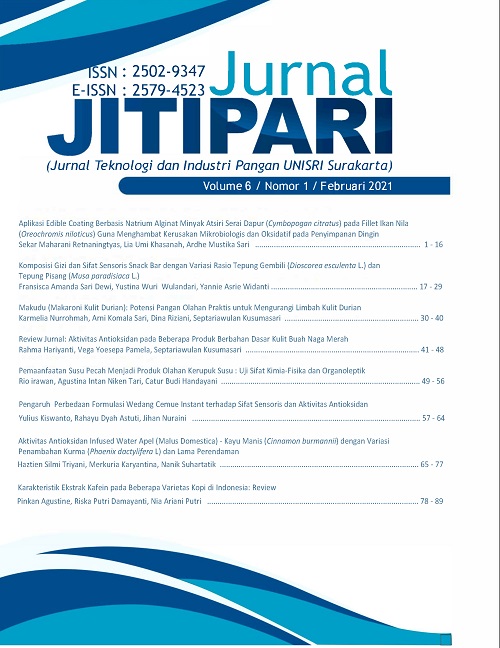PENGARUH PERBEDAAN FORMULASI WEDANG CEMUE INSTANT TERHADAP SIFAT SENSORIS DAN AKTIVITAS ANTIOKSIDAN
DOI:
https://doi.org/10.33061/jitipari.v6i1.4913Keywords:
Cemue Instant, Ginger Extract, Antioxidant ActivityAbstract
Wedang cemue is a traditional drink originating from the Ngawi area, East Java. The existence of wedang cemue is getting eliminated due to the presence of instant drink that we ready to serve and more practical. To preserve the existence of wedang cemue, an innovation is needed that can promote its existence, which is made cemue into to instant. The purpose of this study was to determine the preference of instant cemue, as well as to determine of antioxidant activity. The product preference test (taste, color and aroma) used hedonic scale. The preference test involved 25 panelist. A part from the hedonic test, antioxidant activity test were also carried out using the DPPH test. This study used a Completely Randomized Design with 1 factor that is the variation of formulations (4 formulations). Each formulation was repeated 3 times. The data obtained werw analyzed using ANOVA and further testing with DMRT. The results of cemue instant showed that the formulation I obtained higher acceptability on color (3,84), aroma (3,68) and taste (3,88). The antioxidant activity of formulation I showed the highest result (71,507).References
Antara, N.T. (1997). Aplikasi tehnik
kokristalisasi dalam
pengembangan produk minuman
sehat. Prosiding Seminar
Nasional Teknologi Pangan.
PATPI. Denpasar, Bali.
Dalimartha, S. & Soedibyo, M. (1999).
Awet muda dengan tumbuhan
obat dan diet suplemen. Trubus
Agriwidya. Jakarta
Ella, M.U., Suminarta, K., Suniti, N.
W., Sudiarta, L.P. & Antara, N.S.
(2013). Uji efektivitas
konsentrasi minyak atsiri sereh
dapur (Cymbopogon c) terhadap
pertumbuhan jamur Aspergillus
sp secara in vitro. E-Journal
Agroteknologi Tropika. 2(1), 39-
Farrell, K.T. 1990. Spices, condiments
and seasonings. The Avi Publ.
Co., Inc., Westport, Connecticut.
Fuhrman, B., Rosenblat, M., Hayek, T.
R, Coleman & Aviram, M.
(2000). Ginger extract
comsumption reduces plasma
cholesterol, inhibits ldl oxidation
and attenuates development of
atherosclerosis in atherosclerotic,
apolipoprotein e-deficient mice.
Journal of Nutrition. 130, 1124-
Gespersz, V. (1994). Metode
perancangan percobaan. CV.
Armico Bandung.
Halvorsen, B.L., Kari Holte, Mari C.W.,
Myhrstad, Ingrid Barikmo, &
Erlend Hvattum (2002). A
systematic screening of total
antioxidant in dietary plants.
Journal of Nutrition, 132, 461-
Kiswanto, Y. (2018). Pengembangan
metode pengeringan minuman
serbuk temulawak (Curcuma
xanthorriza Roxb). Proceeding
Seminar Universitas Janabadra,
Yogyakarta.
Lampe, J.W. (2003). Spicing up a
vegetarian diet: Chemopreventive
effects of phytochemicals.
American Journal of Clinical
Nutrition. 78(3), 579 – 583.
Paimin & Murhananta. (1991).
Budidaya, Pengolahan,
Perdagangan Jahe. Panebar
Swadaya. Jakarta.
Shobana, S. & Naidu, K.A. (2000).
Antioxidant activity of selected
indian spices. Protaglandins
Leukotriene Essentials Fatty
Acids. 62, 107-110.
Widjaya , 2003 . Peran antioksidan
terhadap kesehatan tubuh.
Healthy Choice. Edisi IV.
Yen Gow- Chen & Chen Hui Yin.
(1995). Anioxidant activity of
various tea extract in relation to
their antimutagenicity. Journal
Agriculture Chemical. 43(1), 27-
Yusuf, R.R. (2002). Formulasi
karakteristik kimia dan uji
aktivitas antioksidan produk
minuman tradisional sari jahe
dan sari sereh (Skripsi). Fakultas
Teknologi Pertanian, Institut
Pertanian Bogor Bogor.
Downloads
Published
How to Cite
Issue
Section
License
Authors who publish this journal agree to the following terms:
- Authors retain copyright and grant the journal right of first publication with the work simultaneously licensed under a Creative Commons Attribution-ShareAlike 4.0 International (CC BY-SA 4.0) that allows others to share the work with an acknowledgement of the work's authorship and initial publication in this journal.
- Authors can separately make additional contractual arrangements for non-exclusive distribution published by the journal (e.g., publish it in a book), with an acknowledgement of its initial publication in this journal.
- Authors are allowed and encouraged to send their work via online (e.g., in the institutional repositories or their website) after published by the journal.










